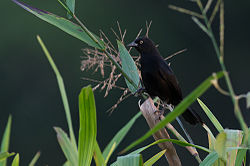| Agelasticus | |
|---|---|
 | |
| Unicolored blackbird (Agelasticus cyanopus), Argentina | |
| Scientific classification | |
| Domain: | Eukaryota |
| Kingdom: | Animalia |
| Phylum: | Chordata |
| Class: | Aves |
| Order: | Passeriformes |
| Family: | Icteridae |
| Genus: | Agelasticus Cabanis, 1851 |
| Type species | |
| Turdus thilius [1] Molina, 1782 | |
| Species | |
3, see text | |
Agelasticus is a genus of birds in the New World blackbird and oriole family Icteridae. They have slender forms and narrow bills. Male plumage is mostly or entirely black while that of females is generally brown and streaky. Females are responsible for building the nest, unlike some of their close relatives. The genus occurs only in South America. [2]







